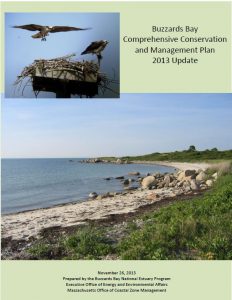2013 CCMP, Action Plan 19:
Protecting Public Health at Swimming Beaches
About the new Buzzards Bay CCMP Action Plans
The Buzzards Bay Comprehensive Conservation and Management Plan (CCMP) was updated in November 2013 to reflect the great progress achieved since the original CCMP was finalized. You can download the entire document (buzzards-bay-ccmp-2013-update.pdf) or just this action plan Protecting Public Health at Swimming Beaches.
Protecting Public Health at Swimming Beaches
Problem
Public and private beaches are found throughout Buzzards Bay (Figure 109) and are an important recreational, aesthetic, and economic resource to the residents of the Buzzards Bay watershed and surrounding areas, and an important source of revenue for municipalities, both in the collection of fees (Table 51), and through the attraction of tourists.
Bathing beaches for many represent the only direct exposure or use of Buzzards Bay, and as such, the quality and condition of bathing beaches plays an important role in the public perception of the health and condition of Buzzards Bay. These bathing beaches also represent potential human exposure to contaminants discharged to surface waters. Of these contaminants, pathogens in particular represent the most important potential threat to public health. Exposure to pathogens by bathers can occur either by direct contact with, or ingestion of, contaminated waters, and may result in illness.
This action plan identifies ways in which local and state government can minimize threats to human health from the risks of pathogen contamination at swimming beaches. The solution to the problems outlined in this action plan will require better designed testing, improved reporting, education of the public, and action to reduce the most serious forms of pollution.
Goals
Goal 19.1. Reduce or eliminate pollution sources contributing to beach closures.
Goal 19.2. Manage beach use to reduce human exposure and health risks based on site-specific conditions.
Objectives
Objective 19.1. Reduce contaminated stormwater discharges to beach areas.
Objective 19.2. Increase public awareness about areas prone to contamination or conditions that may lead to elevated contaminant levels at beaches.
Objective 19.3. Prohibit pet use of beaches and encourage pet waste collection in stormwater drainage areas.
Objective 19.4. Develop and implement more rapid assays to document existing conditions, and where necessary implement preemptive rainfall closures.
Approaches
To meet the goals of this action plan requires two types of actions. First, pollution sources causing beach closures must be identified and eliminated. Second, beaches should be tested more rigorously to capture poor water quality after adverse conditions, such as af-ter moderate to heavy rains. Current beach testing practices only catch these by chance. Evaluating beaches during adverse conditions will better protect the public from water borne diseases and minimize health risk. Municipalities with 15% exceedances each summer at their beaches should test their beaches at least twice per week and conduct sampling to identify sources.
Because staff may have to work after hours to collect samples for such an evaluation of adverse conditions at a beach, this creates a burden. Hiring a contrac-tor to conduct a detailed study of the relationship between rainfall and bacteria levels at the beach may be the sound approach that could allow municipal officials to determine if rainfall conditional beach closures are warranted. MA Department of Public Health and other agencies should continue to evaluate and promote rapid assays.
Programs and regulations to eliminate pets from beaches, or to promote pet waste cleanup in coastal drainage areas can help alleviate problems.
Costs and Financing
Remediating pollution sources can be costly, especially for those beaches near a brook or drainage system where many sources may be contributing to elevated pollution loads. Most of these pollution sources will be associated with stormwater discharges, and these costs are addressed more comprehensively in Action Plan 3 Managing Stormwater Runoff and Promoting LID.
The cost of increased monitoring is relatively modest, but because laboratories charge extra fees if samples are taken at times that require processing during non-working hours, sampling analyses costs can be higher and must be budgeted. Dog waste receptacles have minimal costs and are good education tools.
Measuring Success
The final measure of success of this action plan will be the documentation in the reduction of beach closures for any given sampling scheme.
